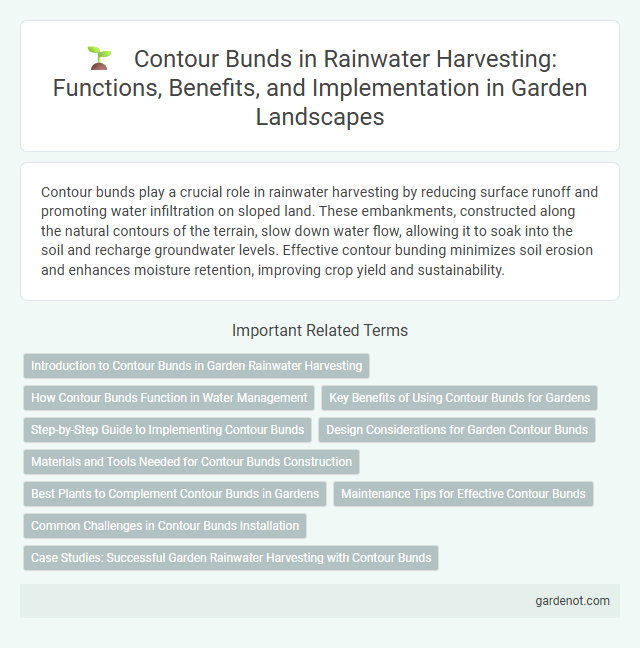Contour bunds play a crucial role in rainwater harvesting by reducing surface runoff and promoting water infiltration on sloped land. These embankments, constructed along the natural contours of the terrain, slow down water flow, allowing it to soak into the soil and recharge groundwater levels. Effective contour bunding minimizes soil erosion and enhances moisture retention, improving crop yield and sustainability.
Introduction to Contour Bunds in Garden Rainwater Harvesting
Contour bunds are earth embankments constructed along the natural contours of a garden slope to slow down rainwater runoff and enhance infiltration. These structures reduce soil erosion and promote water retention, increasing the availability of moisture for plants. In rainwater harvesting systems, contour bunds play a crucial role by directing and distributing water evenly across the garden landscape.
How Contour Bunds Function in Water Management
Contour bunds function in water management by slowing down surface runoff and increasing water infiltration along the natural slope of the land. These embankments constructed along contour lines reduce soil erosion and help retain rainwater, promoting groundwater recharge. Their design maximizes rainwater capture, ensuring better moisture availability for crops and enhanced soil conservation.
Key Benefits of Using Contour Bunds for Gardens
Contour bunds enhance rainwater harvesting by reducing surface runoff and promoting water infiltration in garden soils. They help maintain soil moisture levels, which supports healthier plant growth and decreases irrigation needs. By preventing soil erosion, contour bunds also preserve nutrient-rich topsoil, improving garden productivity and sustainability.
Step-by-Step Guide to Implementing Contour Bunds
Contour bunds improve soil moisture retention by creating barriers along the land's natural slope, reducing erosion and capturing rainwater effectively. Begin by surveying the land to mark contour lines using tools like an A-frame level or a laser level, ensuring accurate alignment with the natural terrain. Next, dig shallow trenches or build earthen embankments along these lines, compacting soil tightly to create stable bunds that slow runoff and promote groundwater recharge.
Design Considerations for Garden Contour Bunds
Design considerations for garden contour bunds include selecting appropriate spacing and height based on soil type and slope gradient to maximize water retention and minimize erosion. Incorporating organic matter along the bunds enhances soil fertility and supports plant growth, while ensuring proper outlet structures prevents waterlogging and structural damage. Regular maintenance and monitoring of bund stability are essential for sustained effectiveness in rainwater harvesting systems.
Materials and Tools Needed for Contour Bunds Construction
Contour bund construction requires locally available materials such as soil, stones, and organic mulch to create effective soil barriers along the slope. Essential tools include spades, hoes, and measuring tapes to accurately mark and dig the bunds following the land's contour lines. Using appropriate materials and tools ensures durability and optimal water retention for rainwater harvesting systems.
Best Plants to Complement Contour Bunds in Gardens
Contour bunds in rainwater harvesting effectively reduce soil erosion and enhance water retention in gardens, creating an ideal environment for moisture-loving plants like vetiver grass and native shrubs such as hibiscus and lantana. Deep-rooted species like vetiver stabilize the bunds by preventing soil displacement, while flowering plants like marigolds and cosmos attract pollinators and improve biodiversity. Incorporating drought-resistant herbs such as rosemary and lavender further complements the bunds by thriving in well-drained soil conditions along the contour lines.
Maintenance Tips for Effective Contour Bunds
Regular inspection and removal of debris from contour bunds prevent blockages and ensure efficient water flow. Repairing any erosion or breaches promptly maintains structural integrity and enhances rainwater retention. Applying vegetation cover stabilizes soil, reduces erosion, and prolongs the functional lifespan of contour bunds.
Common Challenges in Contour Bunds Installation
Contour bund installation often faces common challenges such as soil erosion due to improper alignment, which reduces water retention efficiency and accelerates land degradation. Inconsistent labor quality and insufficient technical knowledge result in poorly constructed bunds that fail to capture rainwater effectively. Moreover, heavy rainfall can cause bund breaches or collapse if the structures are not adequately reinforced.
Case Studies: Successful Garden Rainwater Harvesting with Contour Bunds
Contour bunds have proven highly effective in garden rainwater harvesting by reducing soil erosion and enhancing water infiltration, as evident in multiple case studies across semi-arid regions. For instance, farmers in Rajasthan, India, reported a 30% increase in soil moisture retention and a significant improvement in garden crop yields after implementing contour bunds. These success stories highlight the contour bund's capacity to create sustainable micro-catchments, optimize rainwater use, and promote resilient horticultural practices.
Contour bund Infographic

 gardenot.com
gardenot.com